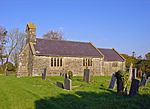Kilgerran Halt railway station
1886 establishments in Wales1963 disestablishments in WalesDisused railway stations in PembrokeshirePages with no open date in Infobox stationRailway stations in Great Britain closed in 1962 ... and 3 more
Railway stations in Great Britain opened in 1886Use British English from April 2021Wales railway station stubs

Kilgerran Halt railway station served the village of Cilgerran, Pembrokeshire, Wales, from 1886 to 1963 on the Whitland and Cardigan Railway.
Excerpt from the Wikipedia article Kilgerran Halt railway station (License: CC BY-SA 3.0, Authors, Images).Kilgerran Halt railway station
Old Quarry Ramp,
Geographical coordinates (GPS) Address Nearby Places Show on map
Geographical coordinates (GPS)
| Latitude | Longitude |
|---|---|
| N 52.0534 ° | E -4.6237 ° |
Address
Old Quarry Ramp
SA43 2SR , Cilgerran
Wales, United Kingdom
Open on Google Maps







